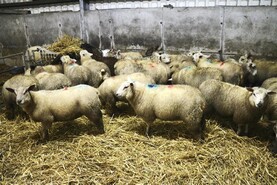It is fair to say that space is at a premium at present on Newford farm in Co Galway. Eighty cows have calved in 30 days and difficulty in getting any cows and calves outdoors has put extra pressure on straw-bedded accommodation. The initial plan was to get 25-30 cows turned outdoors over the weekend but with ground conditions just about fit and a weather warning in place for Thursday and Friday a decision was taken to look at alternatives.
While there is sufficient slatted accommodation available to house cows, there is no creep areas with the two slatted sheds comprising of double-width tanks in place and a feed passage on both sides.
Housing
A temporary creep has been set up in the main suckler cow shed that was originally converted from sheep housing. It was set up by opening one feeding barrier into the passageway on one side of the shed and erecting a creep gate so that calves can access about two and a half bays of the passageway, which in turn has been bedded with a deep layer of straw.

Calves have quickly become accustomed to the creep area with the system working excellently. Calves have quickly become accustomed to the creep area with the system working excellently.
The cows and calves that have been moved to this area are the first 28 cows that have calved and those that calves are suckling well. Farm manager Matthew Murphy says the temporary creep is working great with calves quickly becoming accustomed to passing in and out through the creep gate. The cows have access to three slatted pens and are being fed with ad-lib silage. Slats are also being scraped daily and lime is being applied to minimise the risk of mastitis. As well as freeing up space, the move is also reducing the volume of straw that is required.
The level of snow fall as of Thursday afternoon was low with the greatest challenge to keep water running in troughs. Cows with calves are being treated as priority with yearling cattle on silage requiring a lower water intake.
Calving
Calving is progressing smoothly with no veterinary intervention required and low levels of assistance. There was one calf mortality and the calf from the cow which contracted E coli mastitis is now being fostered onto this cow. There has also been two sets of twins and both are doing fine with cows having sufficient milk to feed both calves. The average weight of calves is 42kg with most ranging from 38kg-46kg.
It is fair to say that space is at a premium at present on Newford farm in Co Galway. Eighty cows have calved in 30 days and difficulty in getting any cows and calves outdoors has put extra pressure on straw-bedded accommodation. The initial plan was to get 25-30 cows turned outdoors over the weekend but with ground conditions just about fit and a weather warning in place for Thursday and Friday a decision was taken to look at alternatives.
While there is sufficient slatted accommodation available to house cows, there is no creep areas with the two slatted sheds comprising of double-width tanks in place and a feed passage on both sides.
Housing
A temporary creep has been set up in the main suckler cow shed that was originally converted from sheep housing. It was set up by opening one feeding barrier into the passageway on one side of the shed and erecting a creep gate so that calves can access about two and a half bays of the passageway, which in turn has been bedded with a deep layer of straw.

Calves have quickly become accustomed to the creep area with the system working excellently. Calves have quickly become accustomed to the creep area with the system working excellently.
The cows and calves that have been moved to this area are the first 28 cows that have calved and those that calves are suckling well. Farm manager Matthew Murphy says the temporary creep is working great with calves quickly becoming accustomed to passing in and out through the creep gate. The cows have access to three slatted pens and are being fed with ad-lib silage. Slats are also being scraped daily and lime is being applied to minimise the risk of mastitis. As well as freeing up space, the move is also reducing the volume of straw that is required.
The level of snow fall as of Thursday afternoon was low with the greatest challenge to keep water running in troughs. Cows with calves are being treated as priority with yearling cattle on silage requiring a lower water intake.
Calving
Calving is progressing smoothly with no veterinary intervention required and low levels of assistance. There was one calf mortality and the calf from the cow which contracted E coli mastitis is now being fostered onto this cow. There has also been two sets of twins and both are doing fine with cows having sufficient milk to feed both calves. The average weight of calves is 42kg with most ranging from 38kg-46kg.







 This is a subscriber-only article
This is a subscriber-only article













SHARING OPTIONS: